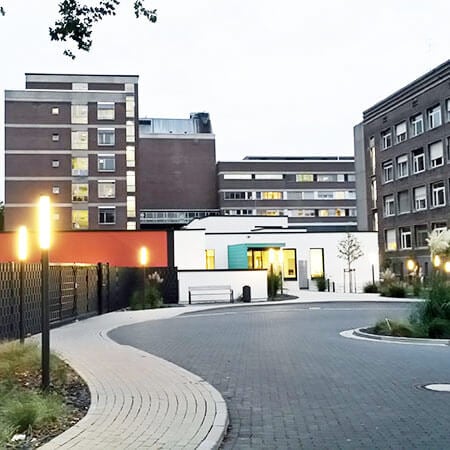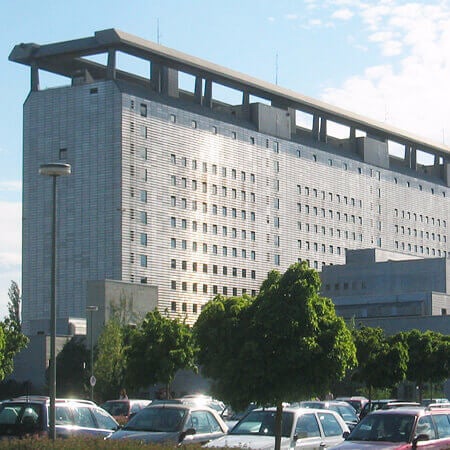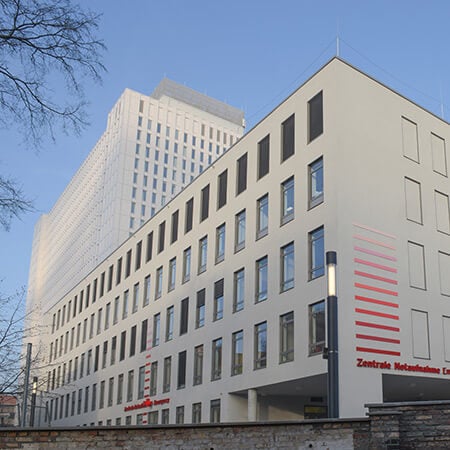Femoral hernia (femorocele, crural hernia)
Femoral hernia is a protrusion of an intestine, omentum or a bladder through the femoral ring. Femorocele often affects babies under one year old and pregnant women. If not treated, the defect causes great danger to a patient’s life. Hernia is peculiar with the unfavorable clinical course and increased risk of infringement, intestinal obstruction, and inflammatory complications.
The Booking Health portal presents 44 German clinics specializing in femoral hernia (femorocele, crural hernia) treatment
Show all clinics
Femoral hernia – Diagnostics
Patient complaints and physical exam results help to diagnose femoral hernia. Visualization techniques, such as ultrasound, X-ray, endoscopy, are applied for the further verification.
Key diagnostic techniques include:
- Ultrasound of the abdominal cavity and herniated protrusion
- Computed tomography
- Irrigoscopy
Modern hospitals can use MRI for diagnostics, as it can identify herniated protrusion and contents of the hernia sac.
Best clinics for the femoral hernia diagnostics in Germany:
Femoral hernia – Treatment
Femoral hernia is treated with surgery and there are many types of operations to remove it. Kind of surgery depends on a hernia type, presence or absence of infringement and also on technical abilities of a hospital.
Main aim of an operation is hernia resection with plastic of the defect (hernia gates). Interventions are performed through various accesses, like the pelvic or femoral one. The defect is closed by the patient's own tissues or synthetic polymeric nets. In the case of hernia infringement it is possible to perform a mid-laparotomy with the removal of non-viable areas of the intestine.
New therapy of femoral hernias. German hospitals and clinics of other developed countries now prefer less invasive laparoscopic interventions. Just three small incisions are required to insert the surgical instruments and a camera that will allow to guide surgeon and provide him with the visual control. Laparoscopic surgery can be done in different ways, depending on the type of hernia. Nevertheless, it has a number of benefits when compared to the conventional operations. A patient can go home next day after a surgery. Rehabilitation period goes quick and risk of complications is the lowest. Laparoscopy ensures good aesthetic results and doesn’t leave large scars on the body.
Best clinics for the femoral hernia treatment in Germany:

Marien Hospital Duesseldorf
6719.6

University Hospital of Ludwig Maximilian University of Munich
9316.8

Charite University Hospital Berlin
13571
Femoral hernia – Rehabilitation
Rehabilitation is the process of body restoration from injuries, surgeries or diseases. It can have a different orientation such as: oncological, orthopedic, neurological, etc. There is also general therapeutic rehabilitation. It is indicated for patients after conservative and surgical treatment of the internal organs diseases.
The directions of the general therapeutic rehabilitation
There are several main directions of the therapeutic rehabilitation such as:
- Medical one, which includes the restoration of patient's health, normalization of body functions, stimulation of compensatory possibilities, elimination of the chronic pain, etc.
- Physical one, which is responsible for improving of work capacity and tolerance for physical activities. In the complex cases, the purpose of this therapeutic rehabilitation area may be the restoration of the self-service ability.
- Psychological one, which helps to eliminate the mental disorders which may occur as a result of a disease (phobias, depression, apathy), to increase the human motivation, and to adapt to the changed living conditions.
The World Health Organization underlines 3 phases of rehabilitation such as: hospital phase, a phase of recovery and supporting phase. Different tasks are solved in different phases. The hospital phase is conducted immediately after the treatment. After the first phase begins the second one which usually takes place in sanatoriums or rehabilitation centers. This is the boundary between two periods, namely illness and future life. Then a supporting phase is required. The patient maintains the achieved level of his health and physical activity at home or visits the rehabilitation center from time to time.
Therapeutic rehabilitation methods
The most modern rehabilitation programs are used in Germany. They are adapted individually for each patient, and are based on the recent disease, age, physical possibilities, and the results of treatment. Different specialists such as: therapists, psychologists, rehabilitators, kinesiotherapists, physiotherapists are involved in the rehabilitation process.
The following methods of rehabilitation are used:
- Dosed physical activity
- Training on the simulators and in the pool
- Physiotherapy
- Acupuncture
- Manual therapy
- Microcurrent therapy
- Compression therapy
- Lymphatic drainage
- Natural factors of the nature (mud, thermal waters, etc.)
Any rehabilitation may include medicamentous support. It is necessary to hold a consultation with the patient about the proper nutrition and the way of life which is important for him in the current situation.
Rehabilitation programs in Germany are designed for 2 weeks. If necessary, they can last much longer. In this country, the patient is provided with qualitative care, accommodation in comfortable rooms and individually selected meals.
Rehabilitation programs in Germany show one of the best results in the world. Most patients successfully restore their employability and excellent health there. They remain physically active, return to the full social and family life.
Best clinics for general therapeutic rehabilitation in Germany:
Author:
The article was edited by medical expert, board certified Dr. Nadezhda Ivanisova. For the treatment of the conditions referred to in the article you must consult a doctor; the information in the article is not intended for self-medication!
Sources:
The cost of services includes
Here you can find the cost of treatment for this disease at the German University Hospitals. Leave a request and we will provide a free consultation with a doctor and will start organizing the whole treatment process.
The program includes the following:
- Issuing of an invitation for getting a visa for treatment as quick as possible
- Fixing an appointment at a time convenient for you
- Preliminary organization of a comprehensive examination and discussion of the forthcoming treatment plan
- Arranging transfer from the airport to the hospital and back to the airport
- Provision of interpreting services and services of a personal medical coordinator
- If necessary, assistance in the organization of further surgical treatment
- Provision of a medical insurance against treatment complications covering up to 200,000 euro
- Preparation and translation of medical records and recommendations from the hospital
- Assistance in the subsequent communication with your attending physician, including consultations on repeated X-ray images through the unique medical document management system E-doc


